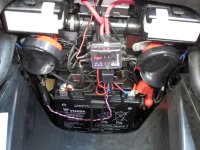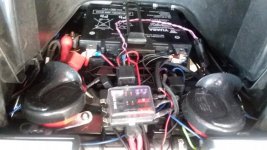The idea behind using a relay is to protect the rest of the Spyder's wiring & instruments, dash etc from excessive voltage/current loads but still get full on heavy duty green steam in the necessary voltage/amperage to your accessory - and a relay does this by allowing you to trigger the power supply to your horn/whatever using the 'lighter'/OE switch wiring connected to terminals 86 & 85; but then instead of running the greater current draw thru the whole OE wiring system, the relay instead allows you to supply your accessory with that full on green steam direct from the battery (via a suitably fused/capacity wire of course!

) connected to terminal 30 on the relay and sent on to the accessory via terminal 87 on the relay.... So really, connecting your relay terminal 30 to anything
BUT the battery OR
at least to a heavy duty purpose designed fuse box/aux power outlet that is itself connected directly to the battery by a heavy, fused wire is sorta defeating the whole purpose behind using a relay in the first place! :lecturef_smilie:
And since our Spyders don't have any 'heavy duty purpose designed/fused aux power outlets' that are heavy enough/up to running the horn anyway, it becomes a case of 'connect your relay power supply direct to the battery'
OR install a dedicated fused power board/fuse box, connect
IT directly to the battery & then connect your relay to that.... only that's multiplying the number of connections that could be potential failure &/or high resistance points in the wiring leading to the horn..... :gaah:
So unless you've already got or are planning to install a whole bunch of accessories running off relays &/or already have a heavy duty power board/fuse box with a substantial & appropriately fused/protected power supply running directly from the battery, then it's simpler & safer to just connect your relay's terminal 30 direct to the battery, - and that's
really what relays were designed to do/how they're meant to work/be installed!

:thumbup:


